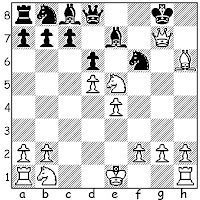The last two posts have shown the dangers that can befall Black if he does not react properly to 5.c3 in the Jerome Gambit. (For an oddly related game, see "Radioactive". Ouch!)
However, as others and I have shown - for an example, see one of my games in the 2008 ChessWorld.net Jerome Gambit thematic tournament - Black certainly has adequate resources.
(Ah, that was a tourney to remember! Although my success was "Overrated!" I was happy to take first place, three points ahead of the field, with a score of 16-2-0, winning 7 out of 9 games with White - and 9 out of 9 games with Black.)
The following game shows Black taking advantage of one downside of 5.c3 - Black can play 5...d5, and after 6.exd5 Qxd5 White does not have the natural hit at the Queen, Nc3.
Knight32 - AsceticKingK9
ChessWorld Jerome Gambit Thematic Tournament, 2011
1.e4 e5 2.Nf3 Nc6 3.Bc4 Bc5 4.Bxf7+
4...Kxf7 5.c3 d5 6.exd5 Qxd5 7.O-O Nf6 8.d3 Bf5
White needs some ideas here, and what he comes up with is not enough to steer the game in his direction.
9.Ng5+ Ke8 10.Nd2 Bxd3 11.Re1 h6 12.Ngf3 Kd7
13.b4 Bd6 14.Nb3 Rae8 15.Be3 e4 16.Nfd4 Nxd4 17.Bxd4 b6 18.Bxf6 gxf6 19.Qg4+ Kc6 20.Nd2 Rhg8 21.Qd1
The position looks ripe for a concluding sacrificial attack that ends in checkmate.
21...Bxh2+ 22.Kxh2 Rxg2+ 23.Kxg2 Rg8+ 24.Kh2 Qg5
White resigned



































